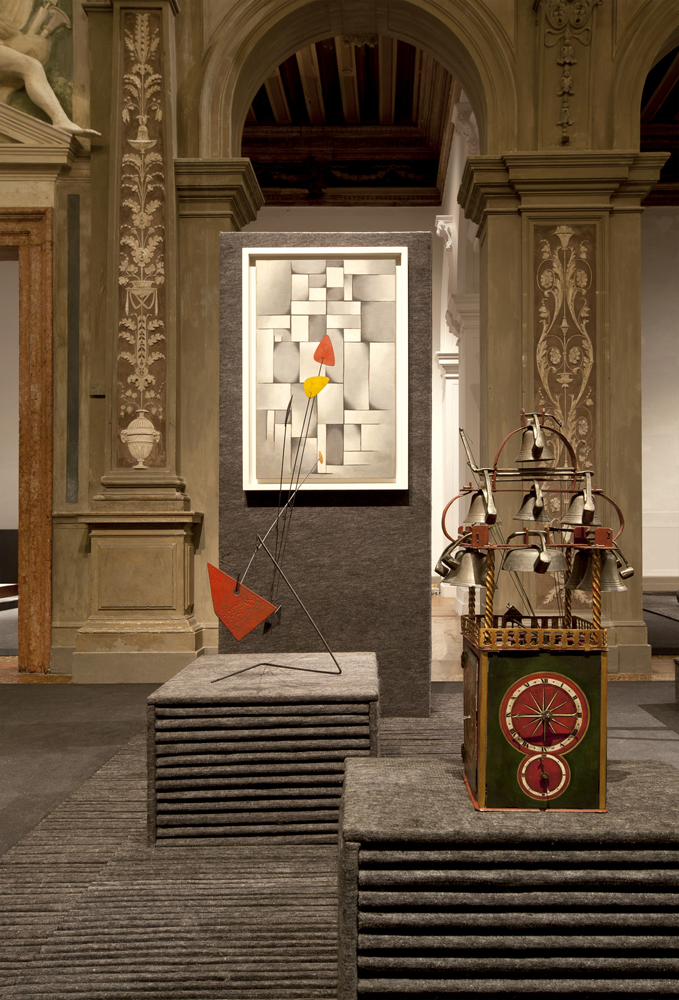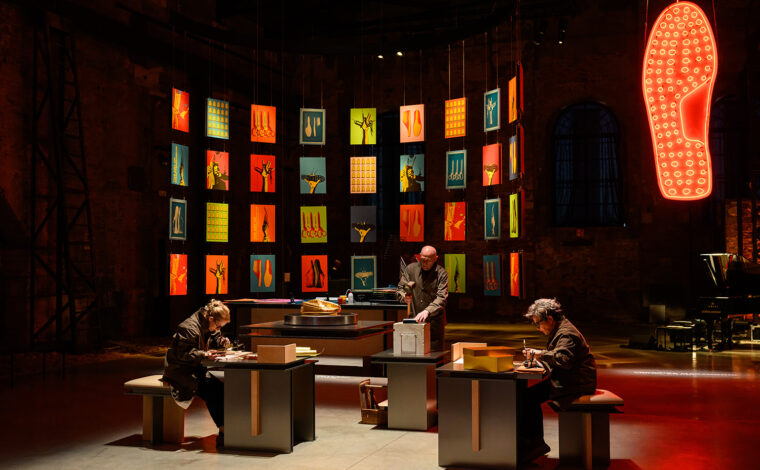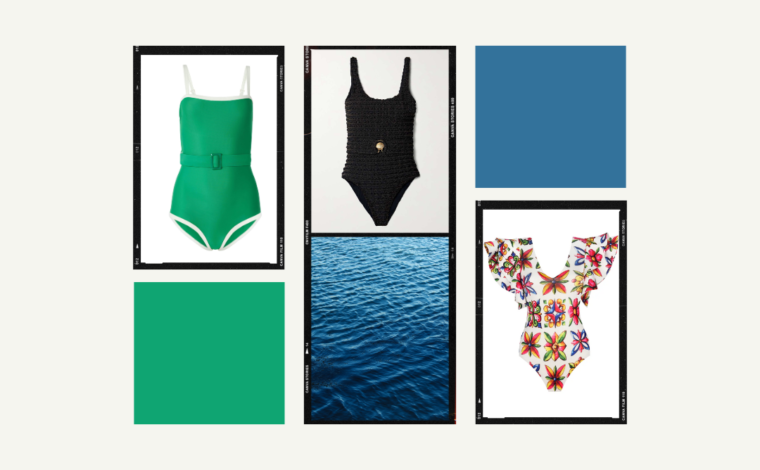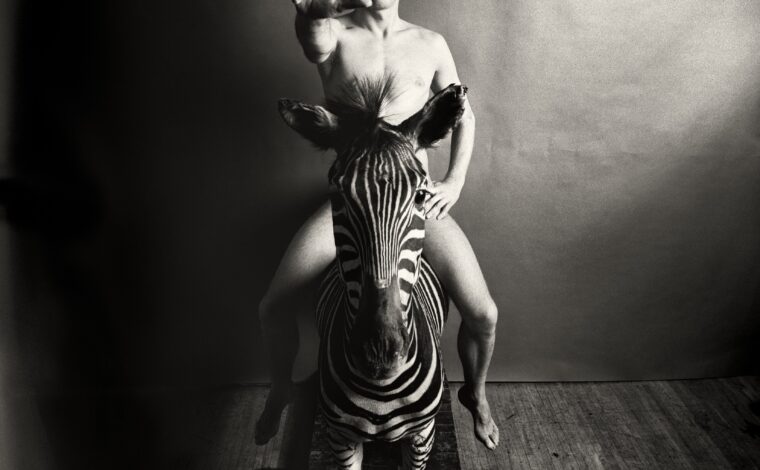Scroll down for english text.
La Fondazione Prada presenta nella sua sede veneziana di Ca’ Corner della Regina la mostra “Art or Sound”, a cura di Germano Celant, dal 7 giugno al 3 novembre 2014.
Concepita come un’indagine attraverso il passato e il presente, “Art or Sound” affronta le problematiche, scaturite dal Cinquecento a oggi, relative al rapporto tra arte e suono, agli aspetti iconici degli strumenti musicali, nonché al ruolo dell’artista musicista e agli ambiti in cui arti visive e musica si sono incontrate.
La mostra vuole indagare la relazione di simmetria e ambivalenza che esiste tra opera d’arte e oggetto sonoro. L’intento è di proporre una rilettura dello strumento musicale che diventa entità plastico-visiva e del manufatto artistico che produce suono, in una continua invasione e inversione di campo.
Il percorso espositivo si sviluppa nei due piani principali di Ca’ Corner della Regina e riunisce più di 180 opere e oggetti, tra automi e macchine musicali, dipinti e partiture, sculture e readymade, strumenti musicali decorati, assemblati, immaginari e silenziosi. Per la prima volta sono utilizzati il portego e le stanze laterali del secondo piano nobile: 800m2 restaurati nel quadro del programma di recupero architettonico intrapreso nel 2011 dalla Fondazione Prada.
Il titolo “Art or Sound” tende a non esprimere un’opposizione, ma piuttosto il confronto tra due ambiti indipendenti. Individua un territorio di libero transito che negli ultimi cinque secoli ha fatto fluire l’arte nel suono e il suono nell’arte, mantenendone la reciproca autonomia. Pertanto lo spettatore, osservando e ascoltando le opere in mostra, è invitato e stimolato a identificare la varietà di trame e percorsi attraverso i quali arte e suono hanno intrapreso un itinerario comune o si sono intrecciati.
Il risultato espositivo e museale aspira a offrire una partecipazione allargata rispetto al percepire univoco del manufatto artistico, dominato dalla dittatura dello sguardo, così da affiancare l’elemento sonoro a quello visivo. Il fine è di esplorare la possibilità di un esporre sempre più multisensoriale dove al vedere si aggiungano l’ascoltare, il toccare, l’odorare e il gustare, così da arricchire attraverso tutti i sensi la conoscenza dell’arte.
Cercando di documentare questo passaggio tra ascoltare e vedere e viceversa, il percorso storico prende il via con i dipinti a soggetto musicale realizzati da Bartolomeo Veneto e Nicola Giolfino tra il 1520 e il 1530 e una serie di strumenti musicali del secolo successivo che, pur riproducendo i suoni in maniera tradizionale, sono caratterizzati da un elemento estetico e visivo che si traduce in una plasticità sorprendente.
Si va, ad esempio, dalle chitarre e violini in marmo intarsiato di Michele Antonio Grandi e Giovanni Battista Cassarini, a un cornetto a forma di serpente e testa di dragone del Seicento, oggetto unico per l’originalità del suo aspetto esteriore e la qualità della lavorazione, nonché per i risultati sonori. A seguire, l’esposizione riunisce una serie di automi musicali settecenteschi, come i preziosi orologi a forma di gabbietta dello svizzero Pierre Jaquet-Droz, già famoso all’epoca in tutta Europa per il grado di eccellenza raggiunto nella costruzione di meccanismi musicali.
Prosegue con strumenti automatici dell’Ottocento come il pirofono, lo strumento a gas inventato nel 1870 da Frédéric Kastner che, se suonato, produce segnali luminosi. Sono presentate anche le ricerche nel campo della sinestesia e le sperimentazioni che, dal Futurismo al Dadaismo, hanno comportato l’integrazione e l’assunzione in musica di rumori, come i celebri intonarumori (1913) di Luigi Russolo, o di suoni vernacolari come il Ciac Ciac (1914) di Giacomo Balla, mentre in With Hidden Noise (À bruit secret) (1916) Marcel Duchamp esplora per la prima volta la dimensione del silenzio nell’arte.
Un particolare rilievo è dato alle partiture originali della fine degli anni Cinquanta elaborate da John Cage, compositore d’avanguardia e figura di riferimento per il movimento Fluxus – rappresentato in mostra dalle opere di George Maciunas e Joe Jones – e per tutti gli artisti che hanno esplorato il principio d’indeterminazione e casualità nella musica e nell’arte contemporanea.
Sul piano dell’oggetto che comunica in maniera tautologica il suono prodotto in fase di costruzione o in grado di esprimersi autonomamente una volta acceso, vengono esposte le scatole di Robert Morris, Nam June Paik e Bruce Nauman, oppure sculture cinetiche realizzate da artisti come Stephan von Huene e Takis. Le opere dei Nouveaux Réalistes, come Arman e Jean Tinguely, documentano attraverso strumenti o dispositivi musicali fenomeni di distruzione e assemblaggio fortuito, mentre Oracle (1962- 65) dell’artista americano Robert Rauschenberg, nel seguire gli stessi principi, si presenta come un environment
sonoro costruito con oggetti di recupero e materiali d’uso comune.
In mostra sono presenti anche esempi di appropriazione iconica e formale dello strumento musicale, come gli insiemi pop – da Tom Wesselmann a Claes Oldenburg e Coosje van Bruggen – o i pianoforti di Günther Uecker, Richard Artschwager e Joseph Beuys, a cui si aggiungono strumenti ibridi, vere e proprie sculture da suonare, come le chitarre e i violini di Ken Butler e i banjo di William T. Wiley. Nel territorio dell’esecuzione e della performance che allarga il significato della pittura, affiancando la presenza di un violinista e di una ballerina che eseguono lo spartito visivo, si pone l’opera Senza Titolo (da inventare sul posto) (1972) di Jannis Kounellis, mentre Handphone Table (1978) di Laurie Anderson, Crossfading Suitcase (2004) di Loris Gréaud e Marble Sonic Table (2011) di Doug Aitken sono opere che richiedono l’interazione con il pubblico per esprimere la loro sonorità.
Questa esplorazione nel territorio aperto, ibrido ed ambiguo tra arte e suono si spinge verso le ricerche più recenti di artisti quali Christian Marclay, Janet Cardiff, Martin Creed, Thomas Demand, Maurizio Cattelan e Rebecca Horn, fino a documentare la produzione di una nuova generazione di artisti sonori o visivi, di performer o compositori rappresentata, tra gli altri, da Anri Sala, Athanasios Argianas, Haroon Mirza, Ruth Ewan, Walter Kitundu, Tarek Atoui, Riccardo Beretta, Pedro Reyes, Alberto Tadiello e Maywa Denki.
Il progetto di allestimento di “Art or Sound”, ideato dallo studio 2×4 di Michael Rock, richiama uno spartito, dove la struttura lineare crea la planimetria e la disposizione ambientale dei supporti, mentre i singoli elementi della scrittura musicale sono sostituiti dagli oggetti e dagli strumenti in mostra. Un materiale fonoassorbente ricopre piedistalli e pavimenti dei due piani di Ca’ Corner e attenua la diffusione allargata dei suoni così da consentirne la percezione relativa ad ogni singola opera.
La mostra è arricchita e completata da una pubblicazione che ricostruisce storicamente e analizza le analogie, le osmosi e le corrispondenze tra le ricerche e le sperimentazioni in campo artistico, sonoro e musicale dal Rinascimento a oggi. Attraverso i numerosi contributi scientifici di artisti e musicisti, storici d’arte e di musica come Jo Applin, Germano Celant, Luciano Chessa, Christoph Cox, Geeta Dayal, Patrick Feaster, Christoph E. Hänggi, Bart Hopkin, Douglas Kahn, Alan Licht, Andrea Lissoni, Noel Lobley, Deirdre Loughridge, Simone Menegoi, Holly Rogers, Jonathan Sterne, David Toop, John Tresch, Eric de Visscher e Rob Young, il volume intende essere un ulteriore contributo allo studio di una percezione multisensoriale delle arti.
– Informazioni sulla mostra
TITOLO: “Art or Sound”
SEDE: Ca’ Corner della Regina, Venezia
INDIRIZZO:
Calle de Ca’ Corner, Santa Croce 2215 – 30135 Venezia
Fermate Vaporetto Linea 1: San Stae e Rialto Mercato
DATE E ORARI DI APERTURA AL PUBBLICO: 7 giugno – 3 novembre 2014; dalle 10.00 alle 18.00.
Giornata di chiusura: martedì. La biglietteria chiude alle 17.30.
BIGLIETTI: Biglietto Intero: 10 €, Biglietto Ridotto: 8 € (studenti entro i 26 anni; Aderenti Carta Giovani Venezia, FAI, Rolling Venice, Touring Club Italiano, Venice Card; gruppi composti da 5 a 25 persone).
Ingresso gratuito: Aderenti ICOM, Deutsche Bank Art Card, visitatori con età inferiore ai 18 anni, senior oltre i 65
anni, giornalisti accreditati o in possesso della tessera stampa in corso di validità.
SERVIZI PER IL PUBBLICO: Visite guidate, a cura di Coop Culture – Venezia, disponibili su prenotazione: +39 041 5240119, fondazioneprada@coopculture.it
Prezzo della visita guidata: 80 euro, oltre il costo del biglietto d’ingresso.
PUBBLICAZIONE: “Art or Sound”, a cura di Germano Celant, pubblicato da Progetto Prada Arte, Milano: 520 pagine, 150 illustrazioni, prezzo di copertina 70 euro (prezzo in mostra 60 euro)
Fondazione Prada presents “Art or Sound”, curated by Germano Celant, at its Venetian venue, Ca’ Corner della Regina. The exhibition runs from June 7 to November 3, 2014. Conceived as an investigation of past and present times, “Art or Sound” explores the relationship between art and sound and the way it has developed from the 16th century to the present day, examining the iconic aspects of musical instruments, the role of the artist-musician, and the areas in which the visual arts and music have come together. The exhibition sets out to investigate the relationship of symmetry and ambivalence that exists between works of art and sound objects. The intention is to offer a reinterpretation of the musical instrument that turns into a sculptural-visual entity and of the artworks that produce sound, in a continual encroachment and inversion of
The exhibition will comprise more than 180 artifacts—clocks and carillons, automata and musical machines, paintings and scores, sculptures and readymades, together with decorated, assembled, imaginary and silent musical instruments—and will occupy the two main floors of Ca’ Corner della Regina.
For the first time the rooms on the second piano nobile will be used: 800 sq. m that have been restored as part of the program of renovation of the building undertaken by Fondazione Prada since 2011.
The title “Art or Sound” is not intended as an expression of opposition, but rather as the encounter between two independent realms. It identifies an area of free transition that, over the last five centuries, has allowed art to flow into sound and sound into art, while maintaining their mutual independence. Therefore the visitor, observing and listening to the works on display, is invited to identify the variety of ways through which art and sound have embarked on the same journey or become intertwined.
The exhibition is organized in order to offer the viewer a broader engagement than that provided by the categorical perception of the artwork dictated by the eye, thus giving both the acoustic and visual elements equal prominence. The aim is to explore the possibilities of a multisensory approach to appreciating exhibits, where the act of seeing is accompanied by those of hearing, touching, smelling and tasting, enriching the understanding of art through all.
Seeking to document the transition between hearing and seeing and vice versa, the exhibition takes a historical perspective, starting out with music-themed paintings by Bartolomeo Veneto and Nicola Giolfino realized between 1520 and 1530, moving on to a series of musical instruments from the following century that, while producing sounds in a traditional manner, are characterized by an aesthetic and visual element that translates into a surprising plasticity.
They range, for instance, from the inlaid marble guitars and viola created by Michele Antonio Grandi and Giovanni Battista Cassarini to a 17th-century cornett in the form of a serpent with a dragon’s head, an object that is unique in the originality of its external appearance and the quality of its craftsmanship and of the sounds it produces. These are followed by a series of 18th-century musical automata, such as the precious clocks in the form of a birdcage made by Swiss craftsman Pierre Jaquet-Droz, already famous all over Europe for the level of excellence he had achieved in the construction of musical mechanisms. The exhibition continues with automatic instruments of the 19th century like the pyrophone, the gas-powered instrument invented in 1870 by Frédéric Kastner that produces luminous signals when played.
It also looks at research carried out in the field of synesthesia and at musical experiments that, from futurism to dadaism, have been made in integrated noises, such as Luigi Russolo’s famous intonarumori (1913), or vernacular sounds like Giacomo Balla’s Ciac Ciac (1914), while in With Hidden Noise (À bruit secret) (1916) Marcel Duchamp explored the dimension of silence in art for the first time.
Particular prominence is given to the original scores from the late 1950s written by John Cage, avant-garde composer and figure of reference for the Fluxus movement—represented in the exhibition by works by George Maciunas and Joe Jones—and for all the artists who have explored the principle of indeterminacy and chance in music and contemporary art. On the side of the object that tautologically communicates the sound produced during its construction or is capable of expressing itself autonomously once turned on, the exhibition presents the boxes of Robert Morris, Nam June Paik and Bruce Nauman, as well as kinetic sculptures made by artists like Stephan von Huene and Takis.
The works of the Nouveaux Réalistes, such as Arman and Jean Tinguely, document phenomena of fortuitous destruction and assembly through musical instruments or devices, whilst Oracle (1962-65) by Robert Rauschenberg, in line with the same principles, is a sound environment constructed out of salvaged objects and commonly used materials.
Also on display in the exhibition are examples of appropriation of the image and form of the musical instrument, such as the pop assemblages by artists from Tom Wesselmann to Claes Oldenburg and Coosje van Bruggen or the pianos of Günther Uecker, Richard Artschwager and Joseph Beuys, along with hybrid instruments, genuine sculptures that can be played, like the guitars and violins of Ken Butler and the banjo of William T. Wiley. Jannis Kounellis’s work Senza Titolo (da inventare sul posto), in which a violinist and a ballerina improvise in front of a painted score, is an example of a performance that broadens the meaning of painting, while Laurie Anderson’s Handphone Table (1978), Loris Gréaud’s Crossfading Suitcase (2004) and Doug Aitken’s Marble Sonic Table (2011) are works that require interaction with the public to produce their sounds.
This exploration of the open, hybrid and ambiguous territory that lies between art and sound leads us to the more recent research of artists like Christian Marclay, Janet Cardiff, Martin Creed, Thomas Demand, Maurizio Cattelan and Rebecca Horn, and then to the production of a new generation of sound or visual artists, performers or composers, represented by Anri Sala, Athanasios Argianas, Haroon Mirza, Ruth Ewan, Walter Kitundu, Tarek Atoui, Riccardo Beretta, Pedro Reyes, Alberto Tadiello and Maywa Denki, among others.
The display system for “Art or Sound”, designed by global consultancy 2×4 led by Michael Rock, is informed by the structure of a musical score. The linear organization determines the arrangement of the bases and pedestals in the environment, while the objects and instruments in the exhibition act as individual elements of a musical notation. The floors and display stands on both floors of Ca’ Corner are covered with sound-attenuating materials allowing visitors to focus on individual works.
The exhibition is accompanied by an extensive publication that reconstructs the analogies, osmosis and parallels between the research and experimentations in art, sound and music from the Renaissance to the present day. Through numerous essays by artists, musicians and historians of art and music like Jo Applin, Germano Celant, Luciano Chessa, Christoph Cox, Geeta Dayal, Patrick Feaster, Christoph E. Hänggi, Bart Hopkin, Douglas Kahn, Alan Licht, Andrea Lissoni, Noel Lobley, Deirdre Loughridge, Simone Menegoi, Holly Rogers, Jonathan Sterne, David Toop, John Tresch, Eric de Visscher and Rob Young, the book sets out to make a further contribution to the study of a multisensory perception of the arts.
INFORMATION ON THE EXHIBITION
TITLE: “Art or Sound”
VENUE: Ca’ Corner della Regina, Venice
ADDRESS: Calle de Ca’ Corner, Santa Croce 2215 – 30135 Venice, Vaporetto Line 1 stops: San Stae and Rialto Mercato
DATES AND OPENING TIMES: June 7 – November 3, 2014; from 10am to 6pm. Closed on Tuesdays.
Ticket office closes at 5:30pm.
ADMISSION FEE: Full: € 10, Reduced: € 8 (students under 26; holders of Carta Giovani Venezia, FAI, Rolling Venice, Touring Club Italiano or Venice Card; groups of 5 – 25 people).
Admission free: holders of the ICOM or Deutsche Bank Art Card, visitors under the age of 18 or over the age of 65, journalists with accreditation or a valid press card.
SERVICES FOR THE PUBLIC: Guided tours, organized by Coop Culture – Venice, available by appointment: +39 041 5240119, fondazioneprada@ coopculture.it
Cost of the guided tour: 80 euros, in addition to the admission fee
BOOK: “Art or Sound”, curated by Germano Celant, published by Progetto Prada Arte, Milan: 520 pages, 150 illustrations,
cover price 70 euros (exhibition price 60 euros).





Comments are off this post!